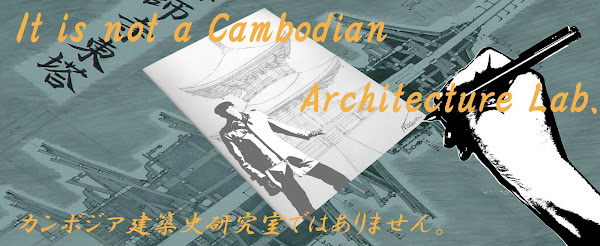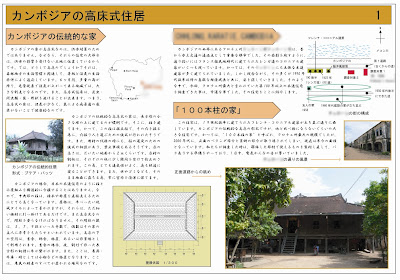Dec 2, 2008
プノンペンホテルでの強盗
11月の最終週、ある人がプノンペンホテルで強盗にやられた。深夜、犯人は、窓の鍵受けを壊して、進入。酒で熟睡している宿泊者に、さらに催眠スプレーを吹きかけて、犯行に及んだ。宿泊者が起床したときには、部屋の中があらされまくれ、私物がベランダに散乱していた。室内にあった、パソコン、ポケットの中の現金(ドル・円)、携帯電話(カンボジア用・日本用)、その他時計などの貴重品が、すべてやられ、被害総額は50万円以上。犯行は、手馴れたプロの仕業と思われ、窓の破壊の仕方から、盗む品物・保管の場所まで熟知していた模様。なぜか、ベランダに荷物がぶちまけてあったため、朝、宿泊者自身で、窓を乗り越えて回収しなければならない羽目に・・・・。なんと、そこに、鉄パイプが!つまり、宿泊者が眼を覚ましたら、危害を加える為に準備していたようだ。もし、宿泊者が気づいていれば、パイプとか刃物とかで・・・・。
今回の問題点
①ベランダから容易に進入できる2階であったこと。
②開けられたカーテンや電気の付けっ放しなど、室内の状況を外から容易に確認できたこと
③宿泊の情報が事前に漏れていた可能性(日本政府関連事業)
カンボジアで私たちが宿泊する際の注意点
①事前にホテル・部屋の下見をしてから、泊まること。
②不在時・睡眠時には、中の様子がわかるような状況を作らないこと。戸締り
③過去の事件やその地区の治安状況を聞き出しておくこと。
④信頼できるホテルを選ぶこと。
⑤貴重品は、すべて金庫に保管すること。
⑥ホテルはやめて、友達の家に泊まる。(わたしは、数ヶ月間、カンボジアの友達の家に居候していた。そのほうが安全)
でも、今回は、プノンペンホテルでの事件。私も一度、行ったことがあるが、サービスもグレードも良く、信頼できる雰囲気であった。それに、周囲は、道路に囲まれ、隣接ビルは、少し離れているので、安心感もあった。でも、やはりカンボジアでは、日本のようにはいかないようだ。
とにかく、私は、被害者の人が、無事に日本に帰ってこられて、また再開できたことでほっとしている。(この人は、ホテルでの強盗とタイ航空のトラブルでカンボジア出張はさんざんだったと言っていた。)
Nov 30, 2008
we cannot send EMS from Cambodia to Japan
Nov 5, 2008
Oct 30, 2008
Airway schedule
Going
l 26 December, from Phnom Penh to Ho Chi Minh
VN818/AT7 18:50(departure)/19:40(arrival)
l 27 December, from Ho Chi Minh to Osaka
VN940/B777 the next day 00:10(departure)/07:00(arrival)
Returning
l 5 January, from Osaka to Ho Chi Minh
VN941/B777 11:00(departure)/14:35(arrival)
l 6 January, Ho Chi Minh to Phnom Penh
VN819/AT7 17:15(departure)/18:05(arrival)
2. PlanA-2 (Hanoi way and you stay during 10 days in Japan)
Going
l 26 December, from Phnom Penh to Hanoi
VN840/A320 15:50(departure)/19:10(arrival)
l 27 December, from Hanoi to Osaka
VN948/B737 23:30(departure)/the next day 05:35(arrival)
Returning
l 5 January, from Osaka to Hanoi
VN949/B737 18:40(departure)/22:20(arrival)
l 6 January, from Hanoi to Phnom Penh
VN841/A320 the next day 08:30(departure)/11:50(arrival)
If you use this way, you must stay one night in Hanoi.
3. PlanB-1 (Ho Chi Minh way and you stay during 8 days in Japan)
Going
l 27 December, from Phnom Penh to Ho Chi Minh
VN818/AT7 18:50(departure)/19:40(arrival)
l 28 December, from Ho Chi Minh to Osaka
VN940/B777 the next day 00:10(departure)/07:00(arrival)
Returning
l 4 January, from Osaka to Ho Chi Minh
VN941/B777 11:00(departure)/14:35(arrival)
l 5 January, Ho Chi Minh to Phnom Penh
VN819/AT7 17:15(departure)/18:05(arrival)
4. PlanB-2 (Hanoi way and you stay during 8 days in Japan)
Going
l 27 December, from Phnom Penh to Hanoi
VN840/A320 15:50(departure)/19:10(arrival)
l 28 December, from Hanoi to Osaka
VN948/B737 23:30(departure)/the next day 05:35(arrival)
Returning
l 4 January, from Osaka to Hanoi
VN949/B737 18:40(departure)/22:20(arrival)
l 5 January, from Hanoi to Phnom Penh
VN841/A320 the next day 08:30(departure)/11:50(arrival)
If you use this way, you must stay one night in Hanoi.
Of course you can make 9 days planning as same above, because it’s just changing the day.
Sep 9, 2008
CJCC students
They have staid near Toyohashi city; Kota town, Aichi prefecture. They visited SOPHIA UNIVERSITY of Tokyo, Toyota factory of Toyota city, Aichi prefecture. And this week they will go to NAGOYA UNIVERSITY, Kyoto as sightseeing. And this weekend will be good-bye.
Sep 6, 2008
新しい韓国人の友達
以外にも初めて韓国人の友達ができた。別にこれは酒の力ではない。すぐに意気投合してしまった。今まで、韓国人の先輩はいたが、友達と言える存在の人間はいなかった。ふーん、眠い。今から、カンボジア人の友達の家に泊まって、寝るかな。
Sep 5, 2008
Sep 4, 2008
建築学会でのカンボジアに関する発表
Sep 3, 2008
修士の主席を取り逃す・・・・・
Sep 1, 2008
KARAOKE
In Cambodia it's very popular. And I watched the KARAOKE channel of TV in Cambodia every day.
Aug 29, 2008
New Cambodian students
Aug 28, 2008
NIAS island of Indonesia
Jumping stone
Jumping stone
the village
プノンペンの高層化
ソバナール
Aug 27, 2008
帰国報告
Jul 9, 2008
Jul 6, 2008
Bayog relief
 This is relief of Bayog. It is the scene where it is making porter. DUMARCAY says, it was drawn for the purpose that they want to prove that the civilization of own is altitude in those days .
This is relief of Bayog. It is the scene where it is making porter. DUMARCAY says, it was drawn for the purpose that they want to prove that the civilization of own is altitude in those days . This is the relief which was drawn on alidade . When they builed Wat, the alidade was used for goniometry. And Paysage of the relief is drawn laterite(?) that was cut down.
This is the relief which was drawn on alidade . When they builed Wat, the alidade was used for goniometry. And Paysage of the relief is drawn laterite(?) that was cut down.
Jul 2, 2008
カンボジアの調査
Jul 1, 2008
Indonesia trip
Jun 29, 2008
ベトナム人とのテニス3
.jpg) ベトナム人2人、日本人2人の集合写真です。いつもなら、もっと人が集まって、他の日本人やベトナム人、中国人、ジンバブエ人たちがやってきます。
ベトナム人2人、日本人2人の集合写真です。いつもなら、もっと人が集まって、他の日本人やベトナム人、中国人、ジンバブエ人たちがやってきます。 私と、カンボジア人のV(奥に横たわっている)の写真です。私とのシングルスの勝負で、Vは負けて、さらに、力尽きて、倒れ込んでいます。で、見物していたベトナム人の女の子が、写真を撮ってくれました。
私と、カンボジア人のV(奥に横たわっている)の写真です。私とのシングルスの勝負で、Vは負けて、さらに、力尽きて、倒れ込んでいます。で、見物していたベトナム人の女の子が、写真を撮ってくれました。
Jun 26, 2008
クメール人の家 高床造り
クメール人の家は長方形の小さな塚の上に建てるのが慣例です。そこに、柱を建てます。床は柱に極めて簡単に取り付けられるだけで、屋根組や壁も柱に接合されています。柱と柱の間は、地面から2mくらいの高さで、丸太が支えています。この丸太が、床または割板を支えているのです。かつて、この柱は掘立柱で、その穴を掘る為に、穴掘り人を選ぶための儀式が行われたそうです。柱の材質は、ソクローム、プチェック、トラーチュ、チリックあるいはクロコッなどが用いられ、ごく稀にトバェン、クロン、チュロモッ、スロラオなどが用いられています。また、用材の伐採の時にも、柱の選定のための儀式や相談があり、禁止事項もあるそうです。柱の数は、12本の場合が多く(3本4列)、家が大きくなるに従って、3の倍数か4の倍数で増えていきます。そのうち、何本かの柱だけが、高い場合があります。12本の柱のうち、4本がおおきく、8本が小さい場合は、「ノロノン」と呼ばれる形式となります。 クメール人の家は、高床式なので、階段を登らなければなりません。その階段の数は、5,7,9段といった奇数で、偶数はその家の主人に不幸をもたらすといわれています。高床の下の空間は、畜舎、鶏舎、物置、あるいは作業場として利用されます。畜舎の場合、夜、牛が繋がれ、ここには割竹で作った長方形の飼槽が備え付けられています。農具、牛車、時としては小船などの物置となります。手工業地帯では、ここを作業場にして、機織や陶器(コンポン・チュナン)やざるなどをつくっています。ここは、農民の財産のすべてが置かれる場所なのです。
最後に友達の家を載せておきます。ここにある写真以外にも、もっとかっこいい写真があったのですが、顔が写っているために載せれませんでした。
高床式の典型的なクメールの住居です。だいたい2mくらいの高さの部分に床があります。柱は3本4列で、正面に9段からなる階段があります。来客があったときは、高床の下の空間を使用します。 ちなみに、この家には、電気も水道もガスもなにもありません。炊事は薪で、水は貯めたものを使用します。このように自然に囲まれて、広い土地を有している家は、とても衛生的に保つことが出来るので、快適かつ健康的に生活することが出来ます。.JPG)
.JPG)
.JPG)
.JPG)
.JPG)
.JPG)
.JPG) これは、また別の家の小屋組みの写真です。谷と棟木が見えます。屋根タイルは、ただ引っ掛けてあるだけです。
これは、また別の家の小屋組みの写真です。谷と棟木が見えます。屋根タイルは、ただ引っ掛けてあるだけです。.JPG) この家の場合、内部の部屋の仕切りは、屋根の構造と無関係です。この家は、幹線道路に面しているために、電気が来ています。
この家の場合、内部の部屋の仕切りは、屋根の構造と無関係です。この家は、幹線道路に面しているために、電気が来ています。.JPG) これも、また別の家です。この家の階段も9段で、階段自体は中央に配置されています。そのほかのつくりは、既に紹介した家とほぼ同じです。
これも、また別の家です。この家の階段も9段で、階段自体は中央に配置されています。そのほかのつくりは、既に紹介した家とほぼ同じです。ただ、最近は家の趣味も近代化してきたようで、主人がお金のある場合、高い杭の部分をプレキャストコンクリートにして、上等な家に格上げしたり、床下部分全部をコンクリートブロックの壁で囲って、新たな部屋とする家が増えつつあります。
.JPG) 内部の部屋は、建物の一番奥にあり、それは中央に廊下兼祭壇の場所があり、その両脇に寝室があります。ただ、部屋といっても、壁で空間を仕切っているだけで、天井はありません。扉もなく、布で目隠しをしています。
内部の部屋は、建物の一番奥にあり、それは中央に廊下兼祭壇の場所があり、その両脇に寝室があります。ただ、部屋といっても、壁で空間を仕切っているだけで、天井はありません。扉もなく、布で目隠しをしています。.JPG) 料理は、このように、割竹の上に直接置いて食べていました。食器が不安定なため、ときどき、下に落ちることがありますが、そんなことは気にしません。食後の清掃もとても楽で、すぐに、寝食を同じ場所ですることができます。
料理は、このように、割竹の上に直接置いて食べていました。食器が不安定なため、ときどき、下に落ちることがありますが、そんなことは気にしません。食後の清掃もとても楽で、すぐに、寝食を同じ場所ですることができます。以上が、私の知っているクメール人の農家の生活風景です。
Jun 24, 2008
Stone Architecture by Dumarcay
I extracted these from above book, which was written about Khmer stone architecture.
*********************************************
Sandstone is a stone with distinct beds. It was often extracted near the construction site. The block of stone was first outlined by a thin ditch cut out with an axhammer and then removed following the line of the bed. This method was also used in Southeast Asia, in particular amongst the Khmers. It is likely that the recommendations of the Mayamata that we mentioned above were used for sandstone. Once removed from its bed, sandstone loses the water that it contains due to evaporation. It brings to the surface a part of the cement that binds together the grains that make up the stone. This cement is left on the surface of the block and forms a hard crust after a month or two. Therefore,stonecutters must cut and sculpt the stone as quickly as possible once it is removed. This is quite inconvenient as if the stonecutters wait too long to sculpt, not only win the hard crust be difficult to cut, but it win also be destroyed. This crust win not reform if the evaporation is completed, which is particularly obvious when the stone is reused. As the reshaping destroyed the protective crust, erosion is quick to follow and particularly destructive. Builders extracted laterite using a process very similar to that used for the extraction of sandstone. However the ditches encircling the blocks were made with the sole tool of the quarrymen. This resembled an axe with a handle measuring 1.20 metres in length. The other side of the blade featured a sturdy head (Ph. 42). After being traced out, the block was removed using this same tool. This left a stair-shaped cut on the face, used to limit the tracing to two sole ditches (Ph. 43). This form of quarry operation spread throughout an of southern Asia, and particularly in Cambodia.
(cut)
The most interesting borrowed technique was that of the forced chocks. From the middle of the 9th century onwards, the Khmer master builders made excellent use of this as can be seen, for example, in the construction of the pyramid of Phimeanakas in Angkor.
(cut)
The Khmers seldom used collected stones. The stones of Vat Phu were used simply because the site was located at the foot of a cliff. Construction stones in Cambodia are extracted. There are many sandstone quarries on the Kulen plateau or in the surroundings of certain temples such as Beng Melea. Sandstone of many qualities was used,principally arenite for the great temple of Angkor Wat, for example,but also harder sandstone such as greywacke for the temple of Ta Kev (greywacke quarries have still not been discovered). Apart from sandstone, laterite was also used and extracted. A large quarry was discovered near the temple of Bantay Srei of which the working face measured about 3 kilometres. There is no difference in the cutting technique between laterite and sandstone. However, taking into account the formation of a crust due to the evaporation of water of the quarry for the sandstone, there is a major difference in their use. While, for laterite, it is easy to make a stock of stones ready for use, the same cannot be said of sandstone. Sandstone must be used as rapidly as possible and its reuse is almost impossible for sidings. This fact was forgotten by the Khmers at the end of the 13th century. We can see numerous restorations with reused stones, which had disastrous results for buildings on which the protruding surfaces quickly eroded away. This can be seen in the last operations of the terrace of the Leper King or on the reliefs of the north-east corner of the gallery of the first floor of Angkor Wat. These reliefs were sculpted in the 16th century on a wall built in the 12th century. In other words, the sculptors had a harder time finishing their work and they destroyed the protective crust that could not be reformed as the quarry water had already evaporated. As a result, the work quickly eroded.
The corbels that cover the galleries of Angkor Wat feature a particular stereotomy. Each element of the roofing is cut in a double right angle whose planes are tilted towards the exterior (fig. 84). This ensured,on the one hand, better coherence to the structure and on the other hand, the runoff of part of the rainwater caught in the vault. This technique has its disadvantages as the slightest movements of the structure deform the corbels. The implementation of the vault was effected from two sides of the sections (the great length of the galleries made this first operation necessary: the division of the vault into sections) by reversing the direction of the stones at right angles, which at the point where they came together, were blocked in place by a keystone. The use of wedges gradually dropped out of use, which can be seen in Cambodia in the Bayon (early 13th century) where the stereotomy is rather consistent. However, it seems that all the teams working on this prestigious worksite did not use the technique. For example,on the southern wall of the first gallery, the work was divided into different panels. On some, wedges were used judiciously, whereas on others, they weren't used at all.
(cut)
Master builders in all climates have always aimed to harmonise the inner and outer appearance of the structure. Usually, between the aspect of the intrados of a vault or that of an interior chimney of a temple and their outer appearance, there are two views which seem irreconcilable. The master builders attempted to correct this difference. The simplest and most widely used solution involved setting a ceiling in the interior space, thus removing the appearance of the chimney of the intrados. This form was used all throughout southern Asia. The trace of one of the oldest ceilings can be seen in Sambor Prei Kuk in Cambodia (Ph. 35) in the octagonal towers. Sandstone hooks inserted in the brick walls of the towers supported a ceiling.
*********************************************
ドュマルセのすごいところは、広範囲の遺跡の特徴を、同時に比較して、まとめあげることに成功したことだと思います。でも、逆にそれが欠点でもあり、詳細については根拠不明慮な部分が多くあると思います。建築の構法や意匠の観点から、時系列上に物証をならべて、系統だてる必要があると思います。
でも、やっぱりこの本は、すごくいい本ですね。
Jun 23, 2008
ベトナム人とのテニス2
今日偶然にも図書館の前で、例のベトナム人に会って、”俺のことを覚えているか”と聞いたら、考え込まれた。ちょっとショック。で、”テニスだよ”と言っても、”ああ、テーブルテニスね”とか言われる始末。つまり、俺のことは、まったく記憶に残っていなんだな。残念、無念。一応、今度のテニスに誘ったけども、たぶん忘れて来ないだろうな。てか、先々週も電話で誘ったけども、来なかったな~。とほほ・・・
Jun 22, 2008
Kompong Som
How I envy you!
I want to go together, but the term I will not leave Japan yet. I arrange my itinerary by oneself. I will arrive to Phnom Penh on July 10, because I have a seminer on July 9. I have regreted that I will not accompany him.
But I have a plan.
If I have a time in next August, I want to go Kompong Som with a Cambodian friend that lives in Phnom Penh. The bus fare from Phnom Penh to Kompong Som is around $8. It's very good price I think.
And more, I have many another plan at Phnom Penh, only for the person.
I cannot wait to go to Phnom Penh, I want to meet a friend soon! I think of the trip night and day.
Jun 19, 2008
BBC about Cambodai
Jun 18, 2008
100,000yen get! for Cambodia
先週の話ですが、うちの大学の海外インターシップの受講生5人のうちの1人に選ばれました。面接での英語の応答は全然ダメだったんですが、結果は合格でした。10万が、あればレンタカーを借りて、いろいろなところへ調査へいくことが出来ます。
いやー、カンボジアが待ち遠しいですね。
Jun 15, 2008
Jun 9, 2008
investigation in Indonesia
Jun 3, 2008
ベトナム人とのテニス
まあ、テニス自体は、それなりに楽しくでき、まあまあ良かった。
だが、一番良かったことは、そんなことではない!
なんと、ついに、あのベトナム人と話をすることができなたのだ!昨年の12月4日の日記に書いたベトナム人とは、あの時以来、まったく会った記憶がなく、存在すら忘れていた。でも先週、突然目の前に現て、一緒にテニスをすることになろうとは・・・。しかも、しゃべってみると、前よりもさらに・・・・。
とにかく、英語が上手い。てか、とっても話上手。何を話題にしても、ハイテンション!となると、こっちもハイテンション!テニスそっちのけで、ずっと二人でしゃべりっぱなしだった。ははは。でも、こういう明るく、活発で、さわやかな性格の持ち主だと、やっぱり人気があるらしく、後から来たジンバブエ人がそのベトナム人に放った言葉は、「君とだけ、テニスをしにきたよ。」だってさ。なにが、「only you」なんだろうね。一瞬、そのジンバブエ人に対して”ばかじゃない”と思ったけども、その場の雰囲気は、その話を違和感なくスルー。回りの人間たちは、そのような発言がよくあることを知っているのか、自然な感じで話しを流していた。本人も、簡単に対応して、すぐに話を切り替え、テニスを続行。別にそのような事は、、日本人ならよくあることだが、ベトナム人の話術を初めて見たので、ちょっとビックリ!んーん。俺ももっと早くに知り合っておけば、よかったな。
ということで、来週の金曜は、また、みんなでテニス!!!ふふふ
May 28, 2008
AIJ about Cambodia
■9月18日(木)オープンスペース(14:56~15:44)
5358 プノンペン(カンボジア)におけるスクウォッター地区に関する研究 その2 ボレイケラ地区における市場の外部空間構成
5359 プノンペン(カンボジア)におけるスクウォッター地区に関する研究 その3 ボレイケラ地区における住居群区域の空間構成
■9月19日(金)居住支援(2)(11:17~11:57)
8162 再定住事業後の住宅建設手法の検討 カンボジア・プノンペン郊外Samaki271実態調査
■9月20日(土)カンボジア(1)(10:34~11:22)
9076 クメールレンガ造祠堂における砂岩の補強技術と損傷・崩壊の原因に関する一考察
9077 クメール寺院の「宮殿」と呼ばれる付属建物について カンボジア コー・ケーに関する研究(III
9078 イースト・メボンとプレ・ループにおける祠堂の平面の寸法計画について 施工手順からみた10世紀のクメール宗教建築における造営手法の基礎的研究
9079 カンボジア、バイヨン寺院の建造過程をめぐる新見解 カンボジア、バイヨン寺院に関する研究 I
クメール建築における木工技術の研究 -天井板を載せるための痕跡から-
9081 王道調査概要と石橋および沿道遺構について カンボジアのアンコール王国時代の王道と橋梁と宿駅に関する総合学術調査 18
■9月20日(土)カンボジア(2)(11:25~12:13)
9082 古代橋に見られる刻み線についての一考察 カンボジアのアンコール王国時代の王道と橋梁と宿駅に関する総合学術調査 19
9083 アンコール時代の古代橋、Spean Ta Ongと大規模な橋梁について カンボジアのアンコール王国時代の王道と橋梁と駅舎に関する総合学術調査 20
9084 Spean memaiの現状報告と立面の相違について カンボジアのアンコール王国時代の王道と橋梁と駅舎に関する総合学術調査(21
9085 Prasat Preah Neak Buosの現況報告と調査概要について カンボジアのアンコール王国時代の王道と橋梁と宿駅に関する総合調査 22
9086 Prasat Preah Neak Bousの伽藍配置計画に関する一考察 カンボジアのアンコール王国時代の王道と橋梁と駅舎に関する総合学術調査(23
May 26, 2008
Royal University of Fine Arts
May 23, 2008
BBQ on the beach of the Pacific Ocean?
But another Cambodian that he live in Hamamatu will come to Toyohashi. So we mabey have a party for him?
May 22, 2008
カンボジア人に内定が出る!
留学生の就職活動は大変な部分もあるので心配していましたが、決まって本当に良かったです。
これで、彼も日本に長期間、滞在する事とができますね。
彼の会社の本社は名古屋にありますから、これからずっと、名古屋人になっちゃうのかな? (かわいそうに・・・)
それと、彼が、これから、就職活動というプレッシャーから開放されて、もとのように元気になってほしいと思っています。
ということで、今週末は、BBQかな?
May 17, 2008
クメール木造建築に関する研究
私は、あの発表に影響を受けて、どうしてもその研究対象の遺跡を訪れたくなり、先月の28日に、シェムリアップのその遺跡へ行ってきてしまいました。
何度、行っても面白いですね。















.JPG)


.JPG)
.JPG)
.JPG)
.JPG)
.JPG)
.JPG)
.JPG)
.JPG)
.JPG)
.JPG)
.JPG)
.JPG)
.JPG)
.JPG)




